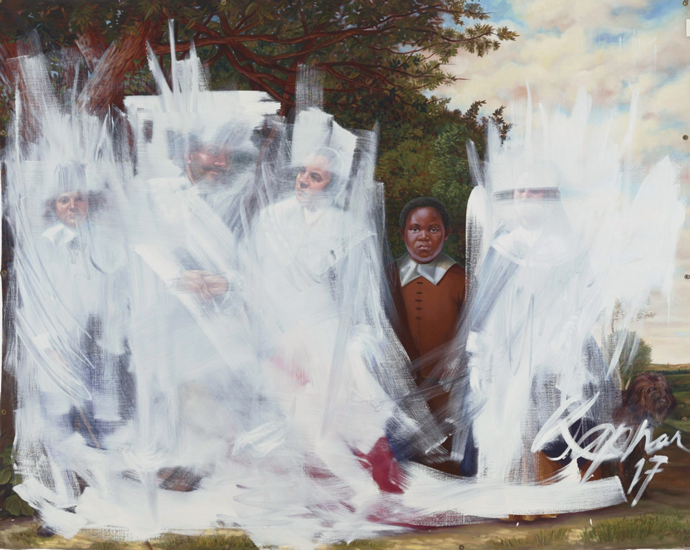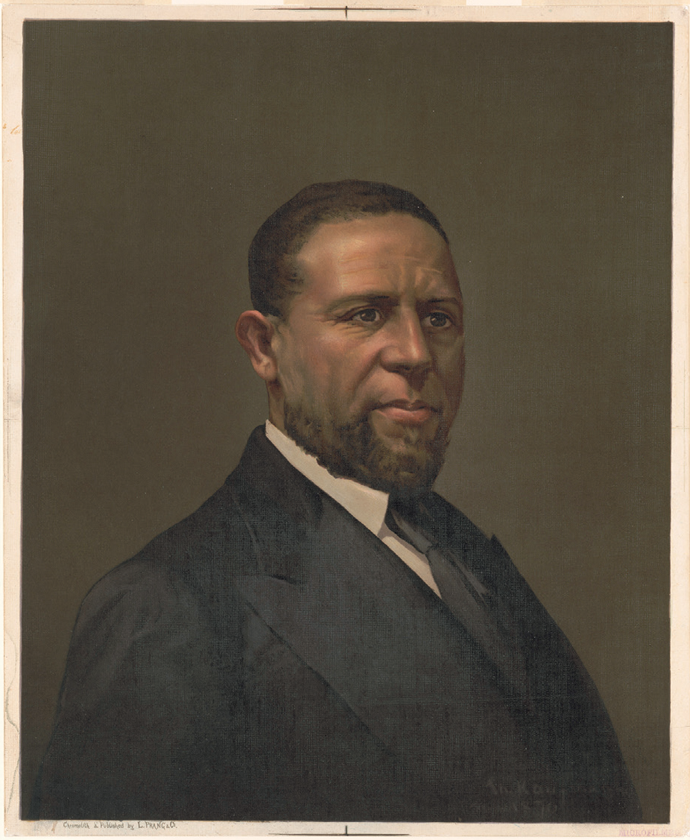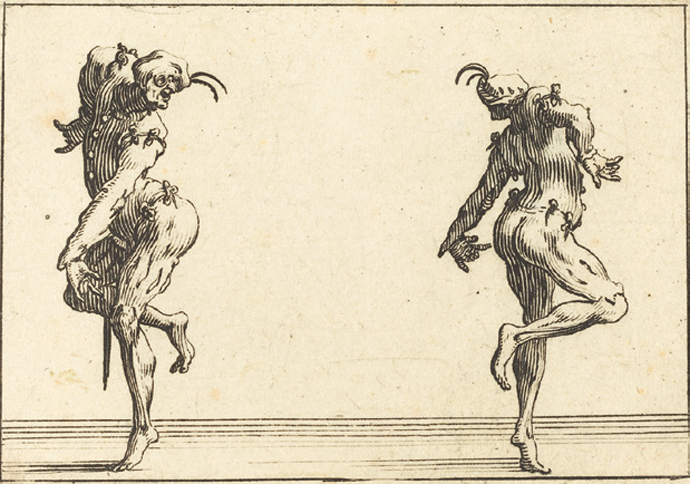Discussed in this essay:
Stony the Road: Reconstruction, White Supremacy, and the Rise of Jim Crow, by Henry Louis Gates Jr. Penguin Press. 320 pages. $30.
Humour, by Terry Eagleton. Yale University Press. 224 pages. $24.
Tears of the Trufflepig, by Fernando A. Flores. FSG Originals. 336 pages. $16.

Shifting the Gaze, by Titus Kaphar © The artist Courtesy Titus Kaphar Studio. Collection of the Brooklyn Museum
In 1899, decades before the Harlem Renaissance brought black writers like Langston Hughes and Zora Neale Hurston to national attention, Charles Waddell Chesnutt published his short-story collection The Conjure Woman. To the casual reader, it was local-color fiction in the vein of Joel Chandler Harris’s Uncle Remus: a carpetbagger buys a war-ravaged North Carolina vineyard and discovers an elderly freedman living off its untended riot of scuppernong grapes. The businessman hires this Uncle Julius, who tells his new employer “conjure tales” from the time of slavery—not quaint plantation odes but Ovidian fables of grotesque metamorphosis, caused by a mysterious power called “goopher.”
Both sinister and comic, goopher turns masters into slaves and slaves into wolves, mules, trees, and lumber that screams at the sawmill. It was slavery’s objectifying logic through the looking glass of folklore—and a sly way for Chesnutt to contest the insidious nostalgia of “plantation school” fiction. In 1901, he issued a bolder challenge to Southern violence with The Marrow of Tradition, a novel about the 1898 white-supremacist overthrow of Wilmington, North Carolina’s mixed-race government.
The book was an unsparing account of Redemption, the political counterrevolution that destroyed Reconstruction’s integrated democracy by vitiating black citizenship. Unlike The Conjure Woman, installments of which had appeared in The Atlantic alongside Henry James, it was not well received. Though he published essays, stories, and speeches until his death in 1932, Chesnutt released his final book in 1905, the same year that Thomas Dixon Jr.’s novel The Clansman, later adapted by D. W. Griffith as The Birth of a Nation, became a national bestseller.
The bloody cultural politics that elevated Dixon and silenced Chesnutt are the subject of Henry Louis Gates Jr.’s Stony the Road: Reconstruction, White Supremacy, and the Rise of Jim Crow (Penguin Press, $30). The book is a timely chronicle of the battle to define blackness that raged from the Civil War through civil rights, pitting influential white racists against the “race leaders” of the New Negro movement. Inverting Frederick Douglass’s famous declaration about slavery and freedom (“You have seen how a man was made a slave; you shall see how a slave was made a man”), Gates asks how “a society attempts to transform a freedwoman or a freedman back into a slave.”
The answer was a multiplatform, cross-class, interdisciplinary, full-spectrum assault on black humanity, and Stony the Road’s vivid survey of recent scholarship demonstrates how painstakingly it was engineered. Redemption’s legal zenith was the Supreme Court’s 1896 decision in Plessy v. Ferguson, the ratification of a segregationist order engineered state by state through overhauled constitutions and terroristic voter suppression. Its aesthetic high tide was The Birth of a Nation (1915), the silver-screen culmination of sentimental plantation novels that slandered Reconstruction and reimagined slavery as a chivalric idyll. Its scientific legitimacy was underwritten by cutting-edge ideas in eugenics and evolutionary biology; opponents of miscegenation warned that intermarriage would lead “back to the jungle forever.”
Perhaps because more energy is required to put genies back in bottles than to release them, the reactionary campaign against black citizenship endured much longer than Reconstruction itself—drawing power, Gates suggests, from its coincidence with pioneering developments in mass media. Stony the Road’s central preoccupation is visual culture, particularly the “remarkable reproducibility” of racist images in advertising, propaganda, entertainment, postcards, and even children’s literature after the Civil War. One of the book’s four photo essays illustrates the normalization of sambo art by a growing national consumer culture: advertisers, taking advantage of innovations in four-color chromolithography, deployed black caricature to sell everything from soap to pancakes.
These denigrating depictions were answered by the New Negroes, a movement to rebrand blackness that included such divergent figures as Booker T. Washington and Alain Locke. Propagating ideal images of black leaders was central to their strategy, an inheritance from image-conscious Reconstruction leaders such as Frederick Douglass. Gates remarks on Douglass’s inordinate fondness for his own likeness; the famous abolitionist also urged “every colored householder in the land” to buy a portrait of America’s first black senator, Hiram Revels. In 1900, W.E.B. Du Bois organized the Exhibit of American Negroes at the World’s Fair in Paris, showcasing more than three hundred and fifty portraits representing black achievement.
Gates, whose own portrait hangs in the Smithsonian’s National Portrait Gallery, writes not only as a scholar of this culture war but as an influential participant. In many ways the inheritor of this New Negro campaign of counterprogramming—Stony the Road accompanies the release of a related documentary for PBS—he might have been tempted to overstate its significance. Instead, he concedes that without a corresponding political mobilization, the New Negro dream had little purchase: “No people, in all of human history, has ever been liberated by the creation of art.” There’s a lesson in this, Gates implies, for contemporary culture: whatever the talent of a Kehinde Wiley or an Amy Sherald, stylizing black excellence is no defense against state violence and voter suppression.

A portrait of Hiram Revels, US senator from Mississippi. Courtesy Library of Congress, Prints and Photographs Division
Why did white audiences find sambo art so funny? Perhaps it was the feeling of superiority stoked by stylized images of black maladroitness; or, perhaps, the sense of incongruity that arose from watching former slaves hold office. Perhaps, after two decades of grudging deference to the victorious Union and its egalitarian reforms, finally being able to “tell it like it is” provided a giddy psychic release.
The superiority, incongruity, and release theories are leading approaches to the study of humor, a universal expression that—unlike, say, beauty—usually dies in transit between eras and cultures. Humor theory searches for the signal in this noise. An ancient discipline presently enjoying a small academic renaissance, it draws together such disparate fields as philosophy, psychology, evolutionary biology, and aesthetics. Terry Eagleton offers a concise and playful primer in Humour (Yale University Press, $24), tracing this slipperiest of concepts from Aristotle and Hobbes through contemporary thinkers such as Simon Critchley and Susan Purdie. The book is also a sensitive appraisal of humor’s contradictory role in politics, where it can serve to level hierarchies but also to erode compassion and neutralize dissent.
The French philosopher Henri Bergson claimed that humor requires “a momentary anaesthesia of the heart.” Robert Frost dismissed it as “engaging cowardice,” the inferior person’s conflict avoidance. The essayist Joseph Addison knocked its bad breeding in an elaborate allegory that scans, in Eagleton’s paraphrase, like a seventeenth-century “yo’ mama” joke: “Laughter is the daughter of Folly, who married Frenzy, the son of Nonsense, whose mother was Falsehood.” Percy Bysshe Shelley looked forward to the final suppression of laughter—a necessary precondition, he believed, to the regeneration of mankind—and even Erasmus, author of In Praise of Folly, chided schoolboys to suppress their farts.
What is humor, and why has it provoked such adamant enemies—not to mention such divergent explanations? Eagleton proves a witty and opinionated, if not exactly sidesplitting, tour guide. In the spirit of Alexander Pope’s “Essay on Man,” he revels in humor’s paradoxical “glory, jest, and riddle,” the way that laughter “is a miming of the noise of the beasts” but also a distinctively human and social practice.
Bergson thought of laughter as a social corrective aimed at those too “inelastic” to keep up with dynamically evolving norms. Studying the medieval tradition of carnival, Mikhail Bakhtin praised its revolutionary capacity to puncture authority’s inviolable aura, using body humor to bring ecclesiastical pomp—or, in his own time, Soviet dogma—“down to earth.” By contrast, psychoanalytic thinkers such as Alenka Zupančič have retorted that comedic transgression only reinforces authority: “there is no harm in an allowed fool.”
Eagleton’s own modest hypothesis is that humor “liberates [us] from the despotism of the reality principle.” Freud thought of jokes as the id’s temporary triumph over taboo, but Eagleton sees them as a fleeting reprieve from the never-ending effort to organize reality. This doesn’t necessarily involve a corresponding political emancipation; humor’s moral meanings, Eagleton insists, are defined socially and historically, inescapably a “class affair.”
Eagleton, a Marxist, is most compelling when he historicizes humor. His case study of its shifting social function is the genteel British humor of the eighteenth century, a rare moment when humor “mov[ed] close to the centre of a dominant ideology.” Bucking a long tradition of humorlessness among Europe’s ruling elites (at least when they dictated morals to the lower orders), a rising bourgeoisie centered on London social clubs invented “good humour.” Epitomized by such writers as Richard Steele and Laurence Sterne, it domesticated political and cultural differences into amusing oddities. Comedy was reconceived as “social lubrication” for a burgeoning world of calculation and commerce—down with aristocratic wit and plebeian profanity, up with affable indulgence.
A revolutionary, egalitarian humor, Eagleton suggests, would unite the instant solidarity of a good joke with satire’s liberating iconoclasm, but without the former’s tendency to dilute necessary power struggles or the latter’s corrosive cruelty. He doesn’t pretend to resolve this polarity between “humour as utopia” and “humour as critique”—essentially, the choice between late-night television’s palatable blandness and Twitter’s micro-targeted spite. But Bakhtin’s concept of the carnivalesque, in Eagleton’s view, comes closest.
It’s a vision of humor as wild, obscene, and subversively collective; if Satire smirks, “You’re a fool,” carnival cries, “We’re Spartacus!” Eagleton largely discusses Bakhtin’s theory itself, rather than its real-world manifestations, but the carnival spirit can be found everywhere from the queer saturnalia of The Rocky Horror Picture Show to the equal-opportunity absurdism of online memes. Of course, like any form of humor, carnival has weaknesses—particularly, an inborn tendency toward the nihilism of lulz. Though it annuls social distinctions, it also risks “reducing everything to the sameness of shit.”

Two Pantaloons Dancing, by Jacques Callot © Album/Alamy Stock Photo
There’s a healthy dose of carnival in Fernando A. Flores’s Tears of the Trufflepig (FSG Originals, $16), a trippy debut novel set in a dystopian near-future South Texas. In this CRISPR-age bender that reads like a cross between Philip K. Dick’s Do Androids Dream of Electric Sheep? and a narconovela, drugs are legal and the cartels sell exotic animals generated via “filtering,” a technology for customizing and cheaply manufacturing organic life. Amid worldwide starvation and mass extinction, filtering produce has become a necessity. Filtering animals, however, is a glamorous crime. Instead of El Chapo, the verses of popular corridos exalt El Gordo Pacheco, a kingpin who kidnaps renowned scientists and forces them to engineer chimeras—silver-coated “moonfoxes,” ivory-billed parakeets—for black-market connoisseurs.
Flores expertly lampoons the narcotraficante predilection for exotic collecting and baroque violence. But his bigger target is authenticity fetishism, the backward-looking, vinyl-loving, locavore culture that distracts, like Nero’s fiddle, from natural and social disaster. Like the contemporary craze for goji berries, ancient wheat, reduced camel-hump fat, and other superfoods, filtering is one of many diversions in a dying world where just about everybody’s head is sunk deep in the sands of nostalgia. People talk on landlines and watch black-and-white movies; the internet and mobile devices have seemingly obsolesced. Rich collectors fuel a white-hot market in looted antiquities and, in a macabre Victorian throwback, the shrunken heads of indigenous people.
The novel’s hard-boiled protagonist, Esteban Bellacosa, loses his brother to the headshrinkers. He leads a lonely life in the fictional border city of MacArthur, Texas, listening to Chopin, lighting devotional candles for his deceased wife and daughter, and whiling away the hours at sleepy taco shops with cute young waitresses. His freelance work as a construction-equipment scavenger takes him back and forth across the militarized border, where not one but two fortified walls now loom over the Rio Grande. (Flores says he completed the novel in 2015.)
While searching for his brother, Esteban joins forces with Paco Herbert, a journalist investigating the filtering underworld and its illegal dinners. They uncover a global conspiracy linking art trafficking, immigration politics, pre-Columbian religion, and a nightmarish bioengineering experiment that recalls Neill Blomkamp’s film District 9. Everything converges on the eponymous “Trufflepig,” a beaked “Tex-Mex platypus” with rheumy eyes and alligator-like skin that influences human dreams. It’s also an avatar of the defunct god Huixtepeltinicopatl, profanely resurrected as a research-animal-cum-designer pet. “Only a matter of time before they bring back Christ through the filtering process,” Esteban muses. “They’ll use [his blood] to cook the meat.”
The satire peaks when Paco and Esteban infiltrate an illegal banquet of jet-setting epicures at a fortified pop-up restaurant. They’re on the paleo diet—paleogenetic, that is—which includes such delicacies as Galápagos tortoise gumbo, goose-butter beefsteak from medieval cattle, and, for an amuse-bouche, “lightly fried gizzards of Mare aux Songes dodo birds” (with aioli). It’s Jurassic Park meets Noma Tulum, the Michelin-starred chef René Redzepi’s ephemeral outpost in the ancient Mayan port recently recast as Mexico’s Williamsburg. Flores conjures a Boschian feast worthy of the sixth extinction; the lotus-eating rich blithely court annihilation in pursuit of unearthly delights.
“Try everything they serve, no matter how disgusting,” Paco tells Esteban. It’s good advice for the reader, too. Fraught with confusing metaphors and expository dialogue, Tears of the Trufflepig is an uneven debut, inconsistently fulfilling the promise of its brilliant, madcap conceit. But Flores has such a distinctive, irresistibly strange sensibility that I almost didn’t care—better half-baked genius than exquisitely turned mediocrity. The novel delivers where it counts; as Chesnutt’s Uncle Julius says in his own freighted parables of American transformation, it’s “powerful goopher.”






























































































